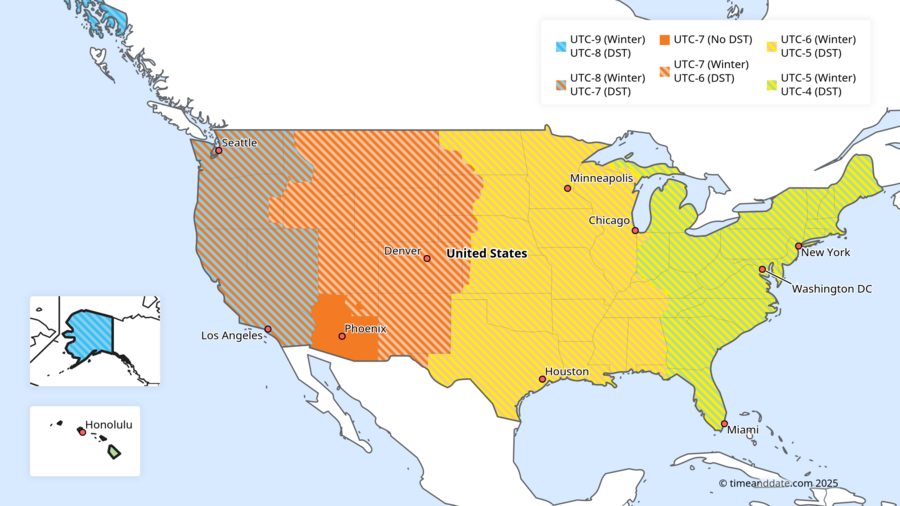
Clocks will be set back 1 hour from 02:00 (2 am) to 01:00 (1 am), local time, on Sunday, November 2, 2025.
US clock change in detailCanada also ends DST on the same date.
DST in the US starts again on Sunday, March 8, 2026.
Longer than in Europe
In Europe, DST will end a week before the US on October 26, 2025.
In 2007, the United States implemented changes to “spring forward” earlier and “fall back” later. The Energy Policy Act of 2005, signed by President Bush, extended Daylight Saving Time to last 238 days, giving Americans more daylight hours in the evening during much of the year. By comparison, Daylight Saving Time in Europe lasts 210 or 217 days per year, depending on the calendar year.
Europe clock change in detailAffects Most of the USA
Most areas in the US change their clocks, except for the following states and territories:

States That Want to “Ditch the Switch”
Currently, 19 states have passed legislation to make DST permanent, while several others have bills in progress but not yet resolved. Most likely, there are bills in other states too. State legislatures have considered over 750 bills and resolutions in recent years to establish year-round daylight saving time as soon as federal law allows it, according to our research.
Permanent Standard Time Also an Option
Any move to permanent DST requires national-level approval in the USA.
Because recent permanent DST bills have stalled in the US Congress, there have been more recent efforts to focus on a move to permanent standard time instead. Any move to year-round standard time does not require national-level approval.
There is a collective drive for permanent standard time (in the US and Canada) from British Columbia, California, Idaho, Oregon, and Washington. Other states in the US are also making moves at a state level to make standard time permanent.
Mexico Removed DST in 2022
Most of Mexico doesn’t have DST. The North American country chose to remove DST permanently in October 2022. However, the change caused both confusion and problems along the US border.
Northern Mexican border towns, such as Tijuana and Juárez (Ciudad Juárez), align their times with the DST schedules of the USA and Canada and will also end DST on November 2, 2025.
Other Locations That Change
DST will also end on November 2, 2025, in Cuba, Bermuda, Bahamas, Saint Pierre and Miquelon, and Thule Air Base in Greenland.
Upcoming DST changes worldwideSet Clocks Back or Ahead?
Daylight Saving Time (DST) shifts the local sunrise and sunset times forward one hour, resulting in more evening daylight. To remember which way to set your watch, keep in mind one of these sayings: “spring forward, fall back” or “spring ahead, fall behind.”
The clocks spring ahead (= losing one hour) in the spring when DST starts, and they fall behind one hour (= gaining one hour) when DST ends in the fall.